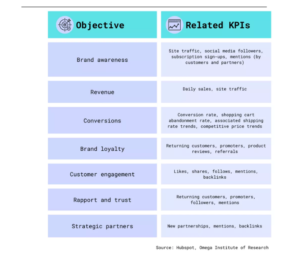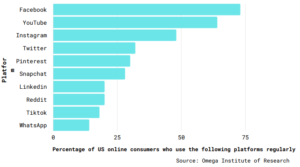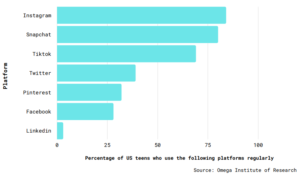- Industries
Industries
- Functions
Functions
- Insights
Insights
- Careers
Careers
- About Us
- Marketing & Advertising
- By Omega Team

Content marketing is a marketing technique in which relevant and useful content is planned, created, distributed, and shared through a variety of channels to reach a clearly identified audience with the objective of driving profitable customer action.
Why should a company utilize content marketing?
There are two types of marketing: outbound and inbound marketing. Outbound marketing is a more obvious form of marketing that interrupts consumers and overtly demonstrates a selling motive. It is less effective than inbound marketing, which reaches the audience in a way that feels natural and organic. Content marketing is a form of inbound marketing that attracts customers by drawing them towards particular types of content they enjoy consuming.
Creating useful and engaging content helps to educate a company’s target audience on the products or services they provide. By demonstrating how offerings solve consumers’ challenges, content marketing allows for fostering trust and relationships between the business and customer. This results in higher conversions, boosted sales, increased brand loyalty, and a stronger sense of community around the company.
How to create content that people will want
The quality of content is critical in determining the success of a particular content marketing strategy. The content must be compelling to consumers and they must genuinely want to seek it out and read it.
The key to attracting an audience is the ability to add value. This means a strategy needs to provide useful and relevant information in order to attract consumers. Moreover, in order to retain traction over time, the content should be engaging to ensure that the audience has a reason to come back and continue consuming it.
Crucial Elements
There are various forms of content that are involved in content marketing. Understanding the features, uses, and advantages of each is crucial in developing an effective strategy to communicate and resonate with customers. Here are a few types of content to consider incorporating:
Social Media Posts
As one of the fastest growing channels for marketing, social media plays a large and important role in content marketing as it is a main way in which content is distributed. Posts can come in many different formats, including pictures, stories, statements, and videos. It is necessary to ensure that there is a variety of content being provided to prevent a feeling of redundancy. Additionally, there must be a fit between the platform and the demographics of the target audience, since each social media app garners a distinct population of users.
Infographics
Infographics, which are usually long and vertical graphics, are a good way to provide important information in an organized format. They typically include statistics, charts, graphs, and other information. In addition to being informative, infographics must be visually pleasing, easy to read, and communicate elements of branding through fonts and colors.
Blogs
A blog is a regularly updated website or web page that can be updated with articles on various relevant subjects. This format allows for a plethora of information to be communicated within each post, and gives room for creativity in terms of topics. It may be harder to keep consumers engaged and focused due to the large amount of content. However, if a company is able to capture a constant population of readers, this customer base will be very loyal.
Podcasts
Podcasts are a creative way to build content around a product or service. 49% of 12 to 32-year-olds in the U.S. have listened to a podcast within the last month, with the average listening time being six hours a week. For this reason, companies are utilizing this type of content to offer useful information, and thus build traction around their product or service offering. Inviting compelling guest speakers to participate is a good way to incentivize listeners to come back and continue listening after each podcast episode.
Videos
Videos can be incorporated into marketing strategy in a variety of ways depending on which social media format they fit. They can be a couple of seconds long, as posted on Instagram stories, or they can be around 30 seconds to a minute long as on Tiktok or Instagram Reels. Moreover, even longer videos can be directly shared as an individual post. Each format requires different levels of focus and engagement from the audience in order to capture attention. Video content is ideal for capturing audience engagement, as it is more impactful. In many cases, focusing on storytelling and testimonials is more impactful to consumers than statistics and numbers, as they are able to resonate more and feel a stronger connection on a personal level.
How to Implement Content Marketing
Step 1: Determine Objective
The first step in developing a content marketing strategy is to identify the end goals. This may be one or more of the following: brand awareness, revenue, conversions, brand loyalty, consumer engagement, rapport and trust, strategic partners, etc. Identifying these objectives is significant because it directly correlates to which KPIs will be important to focus on. KPIs, or key performance indicators, are quantifiable measures of performance for a certain objective or goal, and they help indicate how effective a specific strategy has been. Here are some relevant KPI’s for each marketing objective:
Figure 1: Relevant KPIs for each marketing objective

Step 2: Identify Target Audience
The next step is to determine who we want to communicate the content to. A target audience is the specific group of people that the strategy is attempting to reach through social channels. These are also the people that are most likely to be interested in the company’s products or services. Since they usually share a few common characteristics, they can be targeted through market segmentation. Market segmentation is the process of dividing up customers into smaller, more approachable groups, which makes it easier to determine which channels to reach them through. There are four main types of market segmentation. Demographic segmentation classifies customers based on individual attributes, such as age, race, and gender.
Psychographic segmentation differentiates based on attitudes, aspirations, and values, which can help identify customers with distinct lifestyles, personalities, and opinions. Geographic market segmentation divides people based on where they are physically located. Behavioral segmentation targets customers based on purchase behaviors and decision making patterns.
Another method that can be used to gain a better understanding of how to reach and connect with a target audience is to identify a customer persona. A customer persona is a detailed semi-fictional archetype of the ideal customer. Not only does this provide insight in terms of which channels are necessary to pursue, but it helps a company gain a deeper understanding of who they may be communicating with.
Step 3: Identify Channels
After determining who to reach, the next step is to determine how to reach them. This involves a thorough and analytical thought process regarding the fit and alignment between customer and channel. For example, if social media is the channel in consideration, it is useful to think about what types of people are using each platform, as well as which platforms have the most traffic. These questions are critical in determining the most effective strategy, and depending on the answer, the results will be different.
If the product/service is more general and the target audience is wider, Figure 2 can be referenced below, which depicts the share of US online consumers who use each of the social media platforms regularly. According to the information from the graph, it is apparent that Facebook, Youtube, and Instagram are the most popular platforms. Thus, pursuing a content strategy through these channels would most effectively capture the largest market share.
Figure 2: US Social Media Landscape for Online Consumers

However, if the target audience is narrowed to a certain age group–teens–the answers change dramatically. Figure 3 below indicates the percentage of US teens that use each social media platform regularly. From this new perspective, it is evident that Instagram, Snapchat, and Tiktok will be the most effective platforms to capture this younger audience’s engagement and attention.
Figure 3: US Social Media Landscape for Teens

Step 4: Develop Content
Once the channels are determined, the next step is to develop fitting content that aligns with the specific strategy and the consumers that will be reached. In order to determine what type of content best fits with the strategy, it is necessary to assess relevant KPIs, the audience demographic, and a content format that aligns with the channel used.
Researching trends is also very important to this step, as identifying changes in consumer preferences and the most popular areas of interest are crucial in capturing the attention of the audience. Moreover, trends are an effective method that allows a company to stay relevant in a certain industry or space, and easily attract new consumers to a product or offering.
Step 5: Create a Distribution Plan
When actually carrying out the strategy and distributing the content, social media planning tools and post scheduling platforms help in staying organized and tracking the progress of a campaign. Some things to consider at this step are: maintaining branding principles, covering a variety of content and formats, and providing relevant, valuable, and engaging information. Consistency is critical in growing a consumer base, but it must not cross the line of becoming redundant, as to be considered “spam”.
Subscribe
Select topics and stay current with our latest insights
- Functions